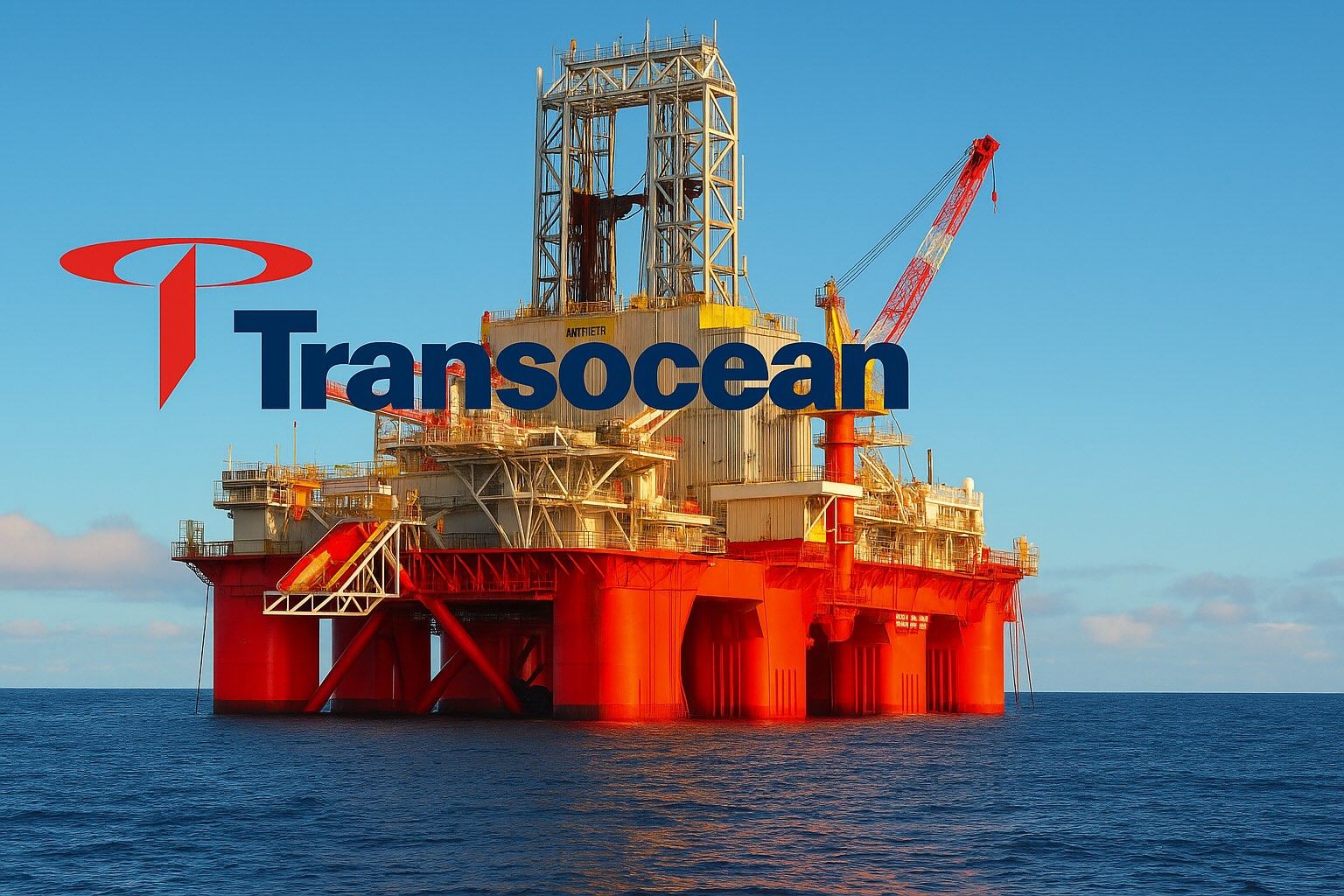- RIG stock jumps: Transocean Ltd. shares trade around the mid-$3 range, near $3.40 as of Oct. 22, 2025, up about 3% today and extending a rebound of ~5% from last week’s lows [1]. The stock is roughly 8% above late-September lows (~$3.14) after a recent string of positive news.
- Insider confidence boost: A major insider, board member Frederik W. Mohn, poured $12.2 million into Transocean stock (buying 4 million shares) during a recent equity offering [2]. The bold insider buy lifted market sentiment and raised Mohn’s stake above 10%, signaling strong confidence in the company’s prospects.
- New contracts & backlog: Transocean secured $243 million in new ultra-deepwater drilling contracts this month, bolstering its order backlog to about $7.2 billion [3]. The fresh deals underscore rising demand for offshore oil projects, a key driver for Transocean’s recovery.
- Debt moves and earnings: To tackle its heavy debt, the company raised $381 million via a stock sale in late September and issued $500 million in new bonds to refinance nearer-term notes [4]. CEO Keelan Adamson says Transocean is on track to cut over $700 million in debt this year [5]. Q3 2025 earnings (due Oct. 29) will include a one-time $1.9 billion impairment for scrapping old rigs [6], which deepens the quarterly loss but “right-sizes” the fleet for higher utilization.
- Analysts cautiously optimistic: Wall Street’s consensus 12-month price target is ~$4.25 (about 25–30% above current prices), though ratings average a “Hold” due to Transocean’s debt load [7]. Some bullish analysts see $5+ upside if offshore drilling momentum continues [8]. Others urge caution (Bank of America’s target is $3 with an Underperform rating [9]), reflecting a mix of optimism and risk awareness.
Transocean Stock Rallies on Fresh Catalysts
Transocean’s stock has been on the upswing in mid-October, buoyed by a series of positive developments. Shares of the offshore drilling contractor jumped over 5% in a single day on October 16 after news of significant insider buying, new contract wins, and proactive debt refinancing hit the market [10]. The most eye-catching vote of confidence came from Frederik Wilhelm Mohn – a Transocean board member and scion of a prominent Norwegian oil family – who purchased 4 million shares (≈$12.2 million worth) in the company’s late-September equity offering [11]. This insider purchase, done via Mohn’s investment firm Perestroika Ltd., is “highly unusual and shows strong conviction in RIG stock” according to MarketBeat analysts [12]. Indeed, Mohn’s move boosted his stake above 10% and helped quell dilution fears, signaling to other investors that those closest to the company see value at current prices.
Another catalyst behind Transocean’s rally has been new contract awards for its drilling fleet. The company recently announced $243 million in additional contracts for two of its ultra-deepwater drillships [13]. These multi-hundred-million-dollar deals immediately add to Transocean’s revenue backlog – which stood at $7.2 billion as of Q2 2025 – and “signal stronger demand for offshore drilling” going forward [14]. Securing new work at healthy dayrates suggests oil companies are green-lighting major offshore projects again. This is a crucial development for Transocean, as higher rig utilization and robust dayrates are key to improving cash flow and earnings after a prolonged industry downturn.
At the same time, Transocean has been aggressively shoring up its balance sheet. In late September, the company surprised the market with a sizeable equity issuance – selling 125 million new shares at $3.05 each (an ~13% dilution) to raise $381 million [15]. While the share sale temporarily knocked the stock down (it priced at an ~11% discount to the prior close, triggering a double-digit drop [16]), management earmarked the cash to pay down high-interest debt, specifically a portion of its 8.00% senior notes due 2027 [17]. The sting of dilution was softened by the fact that insider Mohn bought a large chunk of the offering, and by the end of September the stock had actually rebounded to finish the month up ~5% [18].
Building on those efforts, Transocean raised another $500 million in secured notes in mid-October and launched a cash tender offer to refinance some nearer-term bonds [19]. These steps aim to reduce interest costs and extend debt maturities, improving Transocean’s financial resilience. “We also continue to improve our balance sheet and are on track to reduce our debt by over $700 million this year,” CEO Keelan Adamson said in August, emphasizing the company’s focus on deleveraging [20]. Executives want to ensure Transocean can weather any market volatility until the higher-margin contracts in its backlog translate into stronger free cash flow.
Wall Street has taken note of Transocean’s maneuvers. For example, Bank of America cited the insider buy-in and refinancing moves when it raised its price objective on RIG to $3 (from $2.50), although BofA kept an Underperform rating to signal lingering caution [21] [22]. The recent rally has lifted RIG stock well off its late-September lows (around $3.14), and it closed near $3.31 on October 15 [23] [24]. As of today (Oct. 22), the stock trades around $3.41, continuing its upward momentum. While trading volumes have been modest, the momentum has shifted positive for now, with investors encouraged by Transocean’s proactive steps and insider confidence.
Analyst Commentary and Price Targets
Despite the stock’s rebound, analyst sentiment on Transocean remains mixed, reflecting a balance of the company’s improved outlook and its remaining challenges. On one hand, market forecasts point upward: the average 12-month price target among Wall Street analysts is roughly $4.20–$4.30 per share [25]. If achieved, that implies ~25–30% upside from current levels. In fact, MarketBeat data shows that among 10 analysts, the consensus recommendation is Hold, yet with a projected +30% upside to about a $4.26 average target [26] [27]. The most bullish analysts foresee Transocean stock climbing above $5 (even exceeding its 52-week high of $4.74), while the most bearish have pessimistic targets in the high-$2 range [28]. This wide range – roughly $2.80 to $5.50 – underscores the uncertainty around Transocean’s trajectory, as well as the potential reward if its turnaround stays on course [29].
Several recent analyst actions highlight this cautious optimism. Capital One Financial analyst D. Becker just raised Transocean’s Q4 2025 earnings forecast from $0.07 to $0.08 EPS, signaling slightly higher expectations for the upcoming quarter [30]. For full-year 2025, the consensus earnings estimate stands at $0.14 per share [31], and Becker projects Transocean will remain around breakeven into 2026 (he estimates FY2026 at $0.10 EPS) [32]. Barclays meanwhile bumped its price target from $3.50 to $4.00 and gave RIG an Overweight rating back in August [33] – a notably bullish stance, implying confidence in Transocean’s leverage to an offshore recovery. By contrast, Bank of America’s above-mentioned $3 target with Underperform rating shows that some analysts, while acknowledging progress, still worry Transocean may underperform broader markets [34]. Overall, the street has 3 Buy ratings, 6 Holds, and 1 Sell on RIG [35], and the stock’s consensus rating is “Hold” with a price objective in the low-to-mid $4s.
Commentary from industry observers captures the guarded optimism. “Transocean offers a unique opportunity for investors willing to look beyond today’s oil market malaise,” one analyst wrote recently, arguing that the combination of insider buying, fleet high-grading, and debt reduction “sets a compelling foundation for stronger EPS growth — especially in a rising oil price environment” [36]. Indeed, Transocean’s stock currently trades at an extremely low price-to-book ratio (~0.3x) – a steep discount compared to the broader energy sector’s ~4.5x P/B [37]. This reflects the market’s lingering concerns (high debt, recent dilution, still-recovering rig demand) but also hints at significant value potential if Transocean’s assets and earnings power normalize. In other words, many see RIG as undervalued relative to its assets, provided the offshore drilling upcycle continues.
That said, risks temper the bull case, and even optimistic analysts remain cautious. As noted, Bank of America’s analysts effectively believe Transocean will lag the market near-term – hence the Underperform label – citing the company’s high leverage and the execution risk in meeting its ambitious debt-cutting goals [38]. The upcoming Q3 earnings report on Oct. 29 will be a critical checkpoint. Transocean has already signaled it will take a $1.9 billion impairment in Q3 for scrapping five aging rigs [39], which will deepen the quarterly net loss (though it’s a non-cash charge). Beyond that accounting hit, investors will parse the results for updates on interest costs, rig reactivations, and 2026 guidance [40]. “Investor sentiment appears to be in ‘prove it’ mode,” noted one market observer, describing how RIG’s volatility in October (down ~8% one week, then up 10% the next) reflects traders “digesting a flood of news and trying to gauge if this is the start of a genuine comeback or just a short-term bounce” [41]. For now, the stock’s modest climb and recent support from insiders/instutionals (e.g. Goldman Sachs upped its stake in RIG by 88.9% recently [42]) indicate the Street is giving Transocean a tentative nod – albeit with an eye on oil prices and upcoming results for confirmation.
Oil Market Trends: Offshore Drilling Back in the Spotlight
Transocean’s fortunes are tightly linked to the global oil cycle – and right now, the industry backdrop is mixed but improving for offshore contractors. On the one hand, crude oil prices in late 2025 remain lackluster. U.S. benchmark WTI crude has been hovering in the mid-$50s per barrel (around $56–$59 recently), and Brent in the low $60s [43] [44]. These levels are significantly lower than last year’s averages, reflecting concerns about sluggish demand in major economies and ample global supply. Such “cyclically low” prices [45] have kept many energy investors on the sidelines and have weighed on oilfield service stock performance broadly. In fact, Schlumberger (now known as SLB) noted that high costs in some shale basins are curtailing U.S. drilling, and no major rebound in North American activity is expected near-term at current prices [46]. The U.S. Energy Information Administration (EIA) forecasts oil prices will average around $62 in Q4 2025 and could dip to the low-$50s by early 2026 [47] – a muted outlook that has prompted caution across the sector.
Yet, a deeper look reveals a nascent shift favoring offshore projects, which is crucial for Transocean. As shale growth slows after a decade of rapid expansion, oil producers are increasingly turning back to offshore and deepwater developments to fill future supply. Technological advances have dramatically lowered the cost of offshore drilling, making many new deepwater fields economically viable at today’s oil prices. For instance, some ultra-deepwater projects can now break even at oil prices as low as $20–$35 per barrel [48] [49] – far below typical breakevens for shale wells. “Offshore production will play an increasingly larger role in filling global energy demand,” asserted the CEO of Talos Energy, noting that their Gulf of Mexico projects remain attractive even at ~$35 oil [50]. It’s a striking claim that underscores how efficiency gains (better drilling tech, subsea innovations, etc.) have improved offshore economics. Likewise, Chevron recently affirmed the importance of offshore in its outlook, stating “we believe offshore production will continue to support record [oil] levels…with growth in offshore increasingly supporting supply” [51]. In other words, oil majors expect the offshore segment to pick up the slack as onshore investments moderate.
Evidence of this offshore resurgence is mounting. The U.S. Gulf of Mexico, a key province for Transocean, is projected by the EIA to increase output by ~100,000 barrels/day in 2025 and continue growing into 2026 [52] – a reversal from decline just a few years ago. Globally, deepwater exploration is accelerating from Brazil to West Africa to the North Sea [53] as companies capitalize on improved drilling economics and, in some cases, supportive government policies. Transocean, as one of the world’s largest offshore drilling contractors, is positioned to benefit disproportionately from this trend. The company operates a fleet of 27 mobile offshore rigs (including 20 ultra-deepwater drillships/semisubmersibles and 7 harsh-environment rigs) focused on the deepest waters and toughest conditions [54]. This specialization in high-spec rigs means Transocean is exactly the kind of contractor oil majors call upon for technically challenging new projects.
Recent contract wins hint at the improving fundamentals in Transocean’s niche. During Q2 2025, Transocean landed several marquee contracts – including multi-year charters in the North Sea (Norway) at dayrates near $400,000 per day and in Australia at over $500,000 per day for its top-tier drillships [55]. These rates are a far cry from the lows of the last downturn and indicate that offshore drilling prices have recovered alongside oil companies’ renewed appetite for exploration. Global rig utilization has been ticking upward as well. While the overall U.S. rig count (dominated by land rigs) has seen slight dips recently due to the shale slowdown [56], the offshore segment is clearly on an upswing. A Transocean executive observed that even at $55–$60 oil, many clients are moving forward with deepwater plans because their new projects are profitable at these prices [57]. This resilience suggests that offshore drilling is entering a multi-year upcycle, a sentiment echoed by Transocean’s CEO and peers. “We believe the offshore upturn is here to stay for a while,” Transocean’s CEO Adamson said over the summer, emphasizing the company’s strategy to streamline for efficiency and capitalize on the rising demand (as evidenced by scrapping unneeded rigs and upgrading the fleet).
In short, the broader oil market trends are cautiously favorable for Transocean: commodity prices are not booming, but the mix of investment is tilting back toward offshore projects, which plays into Transocean’s strength. If oil were to rally higher from here, it would likely accelerate offshore spending even more. But even at current prices, many deepwater developments are moving ahead, underpinning Transocean’s backlog and giving management confidence to forecast improving utilization and cash flows ahead.
How Does Transocean Stack Up to Peers?
Transocean’s recent ride must also be viewed in context of its peer companies in the oilfield services and drilling sector. The firm is a mid-sized player by market capitalization, with RIG’s market value around $3.1 billion at present [58]. That is dwarfed by diversified oilfield giants like SLB (Schlumberger) and Halliburton, but comparable to (or a bit smaller than) fellow offshore driller Noble Corp.
SLB (NYSE: SLB) – the world’s largest oilfield services provider – boasts a market cap near $50 billion [59], and its business spans everything from drilling tech to digital services across onshore and offshore markets. SLB just reported Q3 2025 earnings that beat expectations (adjusted $0.69 EPS vs $0.66 est.) and approved a dividend hike [60]. However, SLB’s CEO Olivier Le Peuch struck a cautious tone about North America, noting no major rebound in U.S. shale drilling due to high costs and instead pointing to international and deepwater projects as the drivers of the next growth cycle [61] [62]. This aligns with Transocean’s thesis that offshore is regaining favor. SLB’s stock is down roughly 20% year-on-year [63] [64], reflecting the broader energy weakness, but its global reach and strong balance sheet make it a more defensive play than a pure driller like Transocean.
Halliburton (NYSE: HAL), another oilfield heavyweight (~$22 billion market cap [65]), reported mixed Q3 2025 results. On a GAAP basis Halliburton had a slim net income of $18 million (just $0.02 per share), due to a hefty $540 million impairment charge [66] [67]. Excluding that charge, Halliburton’s adjusted earnings were $0.58/share and the company delivered a robust 13% operating margin [68] [69] – indicating its core business remains quite profitable. CEO Jeff Miller said he was “pleased” with the quarter and highlighted $5.6 billion revenue, slightly up sequentially [70]. Halliburton also announced it is cutting costs and idling some equipment to navigate what it previously warned was a “softer” near-term market for oilfield services [71]. Notably, Halliburton’s North America revenue ticked up 5% in Q3 vs Q2 on higher drilling activity in U.S. land and Canada [72], while international revenue was flat [73]. The company’s ability to remain profitable in this environment and its ongoing shareholder returns (buybacks, dividends) make it a more stable investment than Transocean, but also mean its stock likely won’t have the same explosive upside if offshore drilling enters a boom. Halliburton shares currently trade around $26 (up ~3% after earnings) [74] [75], and like SLB are down roughly 20% from a year ago [76] [77].
Noble Corporation (NYSE: NE) is a closer pure-play peer to Transocean, as it too specializes in offshore drilling. Noble underwent a bankruptcy restructuring in 2020 and emerged as a leaner company. Today, Noble’s stock trades near $28 per share, giving it a market cap of about $4.4 billion [78] – a bit larger than Transocean’s. Investors have thus far awarded Noble a higher valuation, likely reflecting Noble’s cleaner balance sheet and modern fleet post-restructuring. (Noble’s enterprise value is around $6 billion [79], still lower than Transocean’s when including Transocean’s heavier debt load.) It’s worth noting that Noble’s stock has not been immune to volatility: its market cap is down ~26% in the past year [80], mirroring the dip in offshore drilling sentiment earlier in 2025 when oil prices softened. Noble is set to report its Q3 2025 earnings next week (Oct. 27) [81], and investors will be watching if it confirms the same positive trends – rising dayrates, strong backlog, debt under control – that Transocean is banking on. If Transocean’s turnaround succeeds, one could argue its ~$3 billion valuation has room to catch up toward Noble’s, given Transocean’s larger fleet and backlog. For now, though, Noble’s slightly higher market value signals that the market perceives it as a somewhat safer bet in the offshore drilling space.
Other offshore drilling peers include Valaris and Seadrill, both of which also restructured in recent years. Industry-wide, the common theme is that these companies drastically reduced debt during downturn-induced bankruptcies, whereas Transocean managed to avoid bankruptcy but is still working through a significant debt overhang. This leads to a trade-off: Transocean offers higher leverage (and risk), but potentially greater upside torque if the offshore upcycle accelerates; meanwhile, peers like Noble or Valaris might offer a cleaner story but perhaps less dramatic equity upside since a lot of their balance sheet repair is done.
It’s also instructive to compare Transocean’s stock performance to the oil sector broadly. Year-to-date in 2025, Transocean has been volatile but roughly flat-to-up modestly, whereas the broader energy equity indices have been under pressure. For example, the OSX oil services index and integrated majors are down mid-single-digit percentages for the year amid recession worries and oil price swings. Transocean, with its recent rally to $3.40+, is near the higher end of its 6-month range, thanks to the October news. Its beta of ~2.7 means it tends to swing almost three times as violently as the S&P 500 [82], which cuts both ways – rewarding in an upswing, punishing in a downturn. By contrast, an SLB or Halliburton (with betas closer to ~1.5) have been steadier. Investors evaluating Transocean must therefore weigh whether they prefer the steadier, diversified exposure of big oilfield service firms, or the pure-play offshore focus of Transocean and its drilling peers, which could outperform if offshore drilling enters a sustained boom.
Risks and Red Flags for Investors
While the recent news flow around Transocean has been mostly positive, investors should be mindful of several risks and red flags before getting swept up in the rally.
1. Heavy Debt Load and Dilution: Transocean’s balance sheet is still highly leveraged. Even after the latest equity raise and debt refinancing, the company carries roughly $6.5 billion of total debt [83]. Servicing this debt (interest payments) will continue to weigh on cash flows. The recent capital raises demonstrate management’s commitment to deleveraging, but they also highlight that Transocean’s turnaround is coming at a cost to shareholders (dilution and new secured debt issuance). If operational improvements or new contracts don’t materialize as hoped, the company could face tough choices ahead. Execution risk is significant – Transocean must secure high dayrates for its rigs and control costs to meet its debt-cutting goals. Any slip-up (for example, project delays, cost overruns, or a drop in rig utilization) could put pressure back on the balance sheet. The dilution shock from September’s share offering is a case in point: the stock plunged ~13% when that was announced [84]. While insiders stepping in to buy helped recovery, it’s a reminder that equity holders could face more dilution or financial restructuring if the market turns adverse.
2. Oil Price Volatility: The company’s fortunes ultimately rise and fall with oil and gas demand. If crude prices were to take another sharp downturn (say due to a global recession or geopolitical move), oil producers would likely cut back on drilling budgets, and offshore projects – which have long lead times and high capital requirements – could be postponed or canceled. In such a scenario, Transocean’s backlog could suffer and competition for remaining contracts would intensify, potentially driving dayrates back down. The current oil price outlook is uncertain: as noted, EIA sees ~$52 oil by early 2026 [85], which, while sufficient for existing deepwater projects, doesn’t leave a lot of margin for error. Transocean’s recent stability assumes oil stays at least in the current mid-$50s to $60 range. A drop below that (or a significant increase in costs/inflation for drilling operations) would be a major headwind. Conversely, oil price spikes can also be double-edged – while they spur more drilling, they can cause input costs to rise and governments to intervene (taxes, regulations) which could complicate the picture. In short, Transocean is not a self-contained story; it’s a high-beta vehicle on oil trends, and investors need to watch the commodity tape as much as the company specifics.
3. Operational and Regulatory Risks: Offshore drilling is a complex, hazardous business. Transocean has a storied history in the industry (it was the world’s largest offshore driller in the early 2010s) but has also faced its share of mishaps, most infamously the Deepwater Horizon incident in 2010 (on a rig Transocean owned and operated for BP). Safety and environmental incidents can not only incur fines and legal liability but also damage the company’s reputation and client relationships. Just this week, a Canadian court fined Transocean about $65,000 over a 2019 near-fatal accident on one of its rigs offshore Newfoundland [86] [87]. In that incident, a worker was nearly crushed by a crane – thankfully he survived, but with serious injuries. The fine is financially minor for a company of Transocean’s size, but it underscores that operational lapses carry consequences. Transocean is appealing the conviction, maintaining it followed its policies (which the judge found didn’t meet required safety rules) [88] [89]. For investors, the takeaway is the ever-present safety/regulatory risk: stricter regulations (for example, if there’s a political shift toward tighter offshore safety or environmental rules) could raise operating costs, and any major accident could be financially devastating. The offshore industry has improved safety greatly since 2010, but it remains a risk factor that investors in drillers must accept.
4. Upcoming Earnings and Financial Uncertainties: The imminent Q3 earnings release (scheduled for Oct. 29) will give a clearer picture of Transocean’s financial health post-dilution and after recent contract wins. However, investors should brace for a headline net loss in Q3 due to the $1.9 billion asset impairment for rig disposals [90]. This accounting charge, while non-cash, could alarm some and will make the GAAP results look ugly. More important will be the underlying metrics: adjusted EBITDA, cash from operations, backlog updates, and cost guidance. Transocean has to manage through a period of heavy investment (reactivating a stacked rig can cost $50+ million, for example) and one-time charges in order to reap the future rewards. If the Q3 call reveals any negative surprises – say, delays in reactivating rigs, higher-than-expected costs, or any softening in customer demand – the stock could quickly give back gains. Additionally, currency fluctuations (since Transocean operates globally) and interest rate changes (impacting debt interest costs) are external factors that could affect results.
5. Broader Market and Sentiment: Finally, it’s worth noting that Transocean is a relatively small-cap stock in a volatile sector. Broader stock market moves, risk appetite shifts, or rotations out of energy stocks can influence RIG’s share price independently of its fundamentals. For example, if there is a general sell-off in high-beta or small-cap stocks, Transocean might drop even if oil prices and its own prospects remain steady. The stock also has a high retail investor following and presence on platforms like Stocktwits and Reddit, which at times can lead to sudden swings or momentum-driven runs not entirely tied to fundamentals [91] [92]. Investors should be prepared for higher volatility and ensure that fits their risk tolerance.
In summary, Transocean is making meaningful strides in turning its ship around – insiders are betting on it, new contracts are flowing, and the offshore cycle appears to be improving. The stock’s recent rally reflects these positives. However, the company’s journey is far from risk-free: a mountain of debt, a still-recovering industry, and the need for flawless execution form a wall of worry that investors must climb. Potential and peril go hand in hand here.
Outlook: Cautious Optimism for the Coming Months
Looking ahead, the short-term outlook for Transocean will hinge on upcoming catalysts like the Q3 earnings report and any guidance the company provides for 2026. Given the stock’s strong bounce in October, some consolidation or volatility around the earnings date is possible as the market digests the impairment and commentary. However, if Transocean can demonstrate solid operational progress – e.g. improving cash flows, successful reactivation of idle rigs, and evidence that new contracts are contributing to the bottom line – it could reinforce the bullish narrative. Technical indicators have turned favorable in the near term; the stock is trading above its 50-day and 200-day moving averages (around $3.19 and $2.84 respectively [93]), and some analysts note it’s in a “wide and strong rising trend” with potential to rise further within that channel [94]. One technical analysis projects a ~14% climb over the next 3 months, which would put RIG in the high-$3 to low-$4 range [95] – roughly in line with fundamental price targets.
In the mid-term (6–12 months), a lot rides on macro conditions and execution. If oil prices stabilize or grind higher (say, due to OPEC decisions or rebounding global demand), and offshore contract activity continues apace, Transocean could feasibly trade closer to the analysts’ consensus ~$4.20–$4.30 target [96]. Achieving that would likely require the company to hit its debt reduction goals and perhaps show a clear path back to positive earnings (excluding one-off charges). Notably, analysts’ consensus earnings for 2025 and 2026 are modest (pennies per share), so any upside surprise in profitability – for instance, if dayrates rise faster than expected or if Transocean finds additional cost savings – could prompt target upgrades. We’ve already seen Barclays and others edging targets upward as confidence grows [97]. Additionally, as we move into 2026, investors will start looking at Transocean’s order backlog for 2027 and beyond. The current $7+ billion backlog provides visibility into revenue for the next couple of years [98], but replenishing that with new contracts will be crucial to sustain momentum. Any major contract wins (or losses) will be stock-moving news.
It’s also worth considering industry consolidation or strategic moves. Transocean has historically participated in industry M&A (for example, acquiring Ocean Rig in 2018). While the company is focused on debt reduction now, the offshore drilling sector could see further consolidation as players like Seadrill (just out of bankruptcy) or smaller private drillers seek tie-ups. Transocean might explore asset sales (beyond scrapping) or partnerships to enhance its position. Conversely, if its stock remains undervalued and the industry outlook brightens, Transocean itself could become a takeover target by a larger oilfield service company looking to gain offshore expertise (though its debt might be a deterrent). These are speculative scenarios, but in a recovering cycle, strategic moves often come into play.
Bottom line: Transocean is navigating a pivotal moment. There is a growing sense of “cautious optimism” around the company [99] – cautious because of the scars of the past (debt, dilution, volatile oil markets), optimistic because the fundamental tide for offshore drilling seems to be turning in its favor. As one analyst aptly put it, “RIG remains well below its highs, leaving room for potential upside if the offshore recovery continues” [100]. The coming weeks and months will test whether Transocean can convert today’s encouraging signals into a sustained comeback. For investors, Transocean represents a classic higher-risk, higher-reward play in the energy sector: the hooks are in the water, but the catch will depend on execution and a bit of luck with oil prices.
Sources: Transocean and industry data from TS2.tech [101] [102] [103] [104], company press releases and MarketBeat [105] [106], Reuters and Rigzone news on industry trends [107] [108] [109], and other financial analyses [110] [111]. All information is current as of October 22, 2025.
References
1. ts2.tech, 2. ts2.tech, 3. ts2.tech, 4. ts2.tech, 5. ts2.tech, 6. ts2.tech, 7. ts2.tech, 8. ts2.tech, 9. ts2.tech, 10. ts2.tech, 11. ts2.tech, 12. ts2.tech, 13. ts2.tech, 14. ts2.tech, 15. ts2.tech, 16. ts2.tech, 17. ts2.tech, 18. ts2.tech, 19. ts2.tech, 20. ts2.tech, 21. ts2.tech, 22. ts2.tech, 23. ts2.tech, 24. ts2.tech, 25. ts2.tech, 26. ts2.tech, 27. ts2.tech, 28. ts2.tech, 29. ts2.tech, 30. www.marketbeat.com, 31. www.marketbeat.com, 32. www.marketbeat.com, 33. www.marketbeat.com, 34. ts2.tech, 35. www.marketbeat.com, 36. ts2.tech, 37. ts2.tech, 38. ts2.tech, 39. ts2.tech, 40. ts2.tech, 41. ts2.tech, 42. www.marketbeat.com, 43. ts2.tech, 44. www.rigzone.com, 45. ts2.tech, 46. www.reuters.com, 47. www.reuters.com, 48. ts2.tech, 49. ts2.tech, 50. ts2.tech, 51. ts2.tech, 52. ts2.tech, 53. ts2.tech, 54. ts2.tech, 55. ts2.tech, 56. ts2.tech, 57. ts2.tech, 58. www.marketbeat.com, 59. finance.yahoo.com, 60. www.reuters.com, 61. www.reuters.com, 62. www.reuters.com, 63. stockanalysis.com, 64. stockanalysis.com, 65. stockanalysis.com, 66. www.rigzone.com, 67. www.rigzone.com, 68. www.rigzone.com, 69. www.rigzone.com, 70. www.rigzone.com, 71. www.rigzone.com, 72. www.rigzone.com, 73. www.rigzone.com, 74. stockanalysis.com, 75. www.rigzone.com, 76. stockanalysis.com, 77. stockanalysis.com, 78. stockanalysis.com, 79. stockanalysis.com, 80. stockanalysis.com, 81. www.nasdaq.com, 82. www.marketbeat.com, 83. ts2.tech, 84. ts2.tech, 85. www.reuters.com, 86. vocm.com, 87. vocm.com, 88. vocm.com, 89. vocm.com, 90. ts2.tech, 91. ts2.tech, 92. ts2.tech, 93. www.marketbeat.com, 94. stockinvest.us, 95. stockinvest.us, 96. ts2.tech, 97. www.marketbeat.com, 98. ts2.tech, 99. ts2.tech, 100. ts2.tech, 101. ts2.tech, 102. ts2.tech, 103. ts2.tech, 104. ts2.tech, 105. www.marketbeat.com, 106. www.marketbeat.com, 107. www.reuters.com, 108. ts2.tech, 109. www.rigzone.com, 110. ts2.tech, 111. ts2.tech








